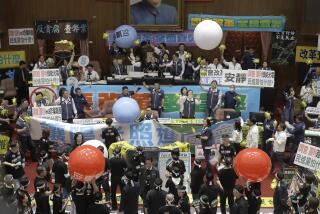A Bridge for Taiwan-China Links
- Share via
KINMEN, Taiwan — The civil war between Communist and Nationalist Chinese was perhaps never more surreal than on this tiny island about a mile off China’s southern coast.
For nearly 20 years, the two sides stuck to an almost comical arrangement to alternate their artillery fire during the week. On Mondays, Wednesdays and Fridays, the Nationalists shelled the mainland from their holdout here on Kinmen. On Tuesdays, Thursdays and Saturdays, it was the Communists’ turn to bombard Kinmen from the mainland.
And on the seventh day, they rested.
“We carried on a normal life but hid whenever the shelling started,” Wong Ching-tse, a 57-year-old Kinmen native, said with a shrug. “We all became used to it.”
Those strange days of China’s extended civil conflict finally ended in 1978. Now, Kinmen--still under Taiwanese control--is at the vanguard of an effort that may push the two bitter rivals, China and Taiwan, slightly closer than at any time in the past half a century.
Moreover, developments on this floating launch pad also known as Quemoy may herald the disintegration of the party that used it to wage its fruitless war against the mainland.
On Tuesday, after two years of delay by the Nationalist, or Kuomintang, government, Taiwan’s parliament approved direct trade and transportation links between its offshore islands, such as Kinmen, and the Chinese mainland--the first such official link since 1949.
The move is largely symbolic. It merely gives official recognition to a thriving trade that has gone on for years, with boats full of food and other goods regularly plying the waters between China and the outer Taiwanese islands in full view of the authorities, who turn a blind eye.
But supporters hope that the move will prove a successful experiment that will eventually expand to include direct links between China and the main part of Taiwan, about 100 miles to the east.
Legislators in Taiwan first introduced the idea of lifting the ban on direct trade and transportation in 1998. The Kuomintang, or KMT, government repeatedly put off the proposal, too distrustful of the mainland, which also pushed for the links.
That was before the historic shift in Taiwan over the weekend, when voters ended the KMT’s 51-year lock on the presidency and elected an opposition politician to lead them. As a result, the KMT has been thrown into disarray, its rank and file angry and alienated.
Analysts say that the chaos within the party allowed the trade link legislation to make it through this time, with the KMT too weak to whip its members into line to oppose it.
It has been left to the opposition Democratic Progressive Party--whose candidate Chen Shui-bian won Saturday’s presidential election--to question the links, warning against haste in making too many concessions to the mainland.
“These [outer] islands exist as a bargaining chip,” said Parris Chang, a DPP legislator. “If you want to give them away for nothing, that wouldn’t be wise.”
Wong doesn’t care about partisan political bickering. He just wants freer trade with the mainland he can see from the waterfront on a clear day. That’s why he moved back to Kinmen from Taipei, Taiwan’s capital, in 1995.
“It seemed as though there might be opportunities for more direct trade and communication links with the mainland,” said Wong, who runs a small shop. “But right now it’s not ideal. The policies haven’t gone very far yet.”
Currently, most trade and investment between China and Taiwan is conducted through Hong Kong, a time-consuming process. Flights between the mainland and Taiwan also go through Hong Kong or Macao.
Kinmen remains fortified against an invasion from China, which considers Taiwan to be part of its rightful territory. Martial law was not lifted here until 1993, six years after it ended on Taiwan proper.
Young cadets rotate through Kinmen constantly as part of the two years of military service compulsory for all Taiwanese men. A pair of helmeted sentries on a platform jutting out over the water keep constant watch for suspicious activity from across the channel.
But even the broadcasting station that used to aim Taiwanese propaganda at the mainland now beams over pop music and news features instead.
Yang Hui-yu, 20, doesn’t fear the mainland, despite its proximity.
“We’re not nervous. We joke that we’re getting our five-starred flags ready,” she said, referring to the mainland’s Communist banner.
Wong has practical considerations. “If their People’s Liberation Army soldiers wanted to come attack Taiwan, they wouldn’t attack us first. Why would they, when they have weapons that can reach Taipei directly?” he said.
“If Taipei falls, then Kinmen does too. They wouldn’t waste their time and resources on us first,” Wong said. “They wouldn’t be that stupid.”
More to Read
Sign up for Essential California
The most important California stories and recommendations in your inbox every morning.
You may occasionally receive promotional content from the Los Angeles Times.














